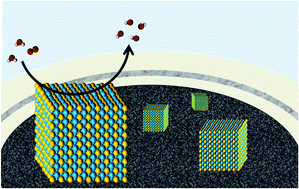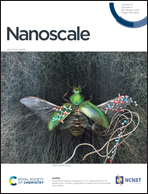Intermetallic Pd3Pb nanocubes with high selectivity for the 4-electron oxygen reduction reaction pathway†
Abstract
Pd-Based nanoparticles are excellent alternatives to the typically used Pt-based materials that catalyze fuel cell reactions. Specifically, Pd-based intermetallic nanomaterials have shown great promise as electrocatalysts for the oxygen reduction reaction (ORR) in alkaline media; however, their synthesis remains a challenge and shape-controlled nanoparticles are limited. Here, a low-temperature approach to intermetallic Pd3Pb nanocubes is demonstrated and their electrocatalytic properties evaluated for the ORR. The intermetallic Pd3Pb nanocubes outperformed all reference catalysts, with a mass activity of 154 mA mgPd−1 which is a 130% increase in activity compared to the commercial Pd/C reference and a 230% increase compared to Pd nanocubes. Tafel analysis reveals that the Pd3Pb nanocubes are highly selective for the 4-electron reduction pathway, with minimal HO2− formation. Density functional theory (DFT) calculations show that the increased activity for the intermetallic nanocubes compared to Pd is likely due to the weakening of OH* adsorption, decreasing the required overpotential. These results show that intermetallic Pd3Pb nanocubes are highly efficient for the 4-electron pathway of the ORR and could inspire the study of other shape-controlled intermetallics as catalysts for fuel cell applications.

- This article is part of the themed collection: Editor’s Choice: Controlling anisotropy in nanomaterials


 Please wait while we load your content...
Please wait while we load your content...